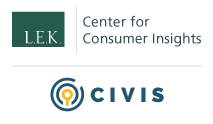

COVID-19 in the US: Consumer Insights for Businesses — Edition 2, Part 2
Brought to you by L.E.K. Consulting's Center for Consumer Insights, in partnership with Civis Analytics
- Article


Brought to you by L.E.K. Consulting's Center for Consumer Insights, in partnership with Civis Analytics
In partnership with Civis Analytics, we’re publishing a series of insights on the consumer response to COVID-19. Our goal is to help our consumer-facing clients monitor sentiment and behaviors as they take shape during this unprecedented period. At the same time, we acknowledge that the pandemic is a humanitarian crisis first and foremost. We at L.E.K. Consulting extend our heartfelt sympathies to all who are affected by this crisis.
Our COVID-19 Consumer Insights Series reflects the results of a recurring consumer pulse survey. Administered approximately every two weeks, the survey tracks the pandemic’s impact on consumer sentiment overall, as well as by segment, geography and product. Each edition offers an updated perspective on the current landscape and what the lasting impact will likely be.
Edition 2 reflects responses captured on April 1, 2020, from ~2,400 U.S. consumers who are demographically representative of the general population. On various charts, we compare how responses have trended since Edition 1 of the survey (~2,600 responses captured two weeks prior, on March 18, 2020).
Initial insights from this second edition of the survey were published earlier this week and can be found here in case you missed them. We are excited to share a number of additional insights from Edition 2 with you now, including:
Important note: All forward-looking data reported are a reflection of consumer sentiment/expectations as of the second edition of the survey and are not official L.E.K. forecasts.
In Part 1, we reported that the impact to travel spend has been significant. Across all business and leisure travel categories tested, U.S. consumers self-report significant reductions in 2020 travel spend due to cancellations or avoidance, ranging from -40% to -80% of total planned spend.
Further analysis reveals that this reduction in spend is driven by significant cancellation rates: between 80% and 100% of consumers who had travel plans canceled some or all of those plans. Of those who made cancellations, more than half canceled all (100%) of their planned 2020 travel spend.
We also asked consumers to imagine a future once the outbreak is contained. In that future, we asked them to estimate what “new normal” spending patterns might look like for travel categories.
Consumer outlook for travel spend post-outbreak is pessimistic. While ~30%-45% of consumers expect travel spend to rebound to pre-outbreak levels, a greater portion of consumers expect spend to remain dampened even after the outbreak is contained. Only a small portion of consumers expect spend to exceed pre-outbreak levels once the virus is contained.
Consumers today are more optimistic about their business travel recovery than they were two weeks ago, while leisure travel recovery expectations remain pessimistic across most categories.
We also asked consumers to imagine their future (i.e., once the outbreak is contained) spend for nontravel categories.
Consumers are more pessimistic as of Edition 2 (April 1) relative to Edition 1 (March 18). Consumers expect to experience a broad-based pullback in spending once the outbreak is contained relative to pre-outbreak levels. This may be driven by poor consumer economic sentiment as well as income reductions during the outbreak.
Expectations for dining out and taxis/ridesharing were most negative. On average, consumers anticipate their average monthly spend on those categories to be significantly lower than pre-outbreak levels. These shifts may reflect strained finances and a need to stay at home to reduce discretionary spending.
Groceries are a notable exception. Consumers, on average, expect grocery spend to slightly exceed pre-outbreak levels, which may indicate a desire (or expected necessity) to eat at home more often.
Not surprisingly, consumers report that the portion of spend made online has increased during the outbreak across categories, notably so for groceries.
Once the outbreak is contained, consumers state that they expect some of the shift online to be permanent for many categories, particularly (again) for groceries.
As a reminder, we’ll be conducting recurring consumer pulse surveys approximately every two weeks to continually monitor consumer attitudes and behaviors.
We understand that many of our clients are facing new disruptions and increased uncertainty in their business outlook. In addition to this work, all of our sector teams are preparing insights on how the latest developments are shifting consumer attitudes, international business flows, commodities pricing and commercial priorities. Some of these changes are likely to endure well beyond when the current pandemic has passed. While many of these changes will create challenges, there will also be new opportunities that emerge. We will be sharing our ideas and insights through our website and other media over the coming days and weeks.
We wish good health to you and your loved ones, and we look forward to continuing to support our clients through this difficult time.
To continue the discussion, please don’t hesitate to contact us.